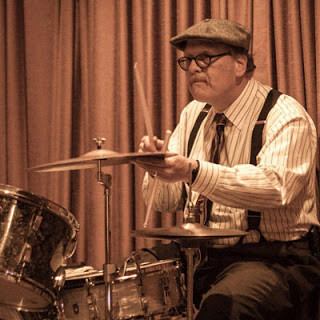
Hal Smith: During the seemingly endless nationwide lockdown, I have enjoyed one positive experience: participating in a series of video discussions regarding the Benny Goodman Orchestra, 1934-36, with emphasis on the rhythm section. The programs are hosted by Loren Schoenberg, with Nick Rossi and this writer as guests. Loren—based in New York City—is a professional musician, bandleader, historian, author, expert on the music of Benny Goodman and Lester Young, Senior Scholar at the National Jazz Museum in Harlem and two-time Grammy Award winner for album notes. Nick is also a full-time musician, bandleader and historian (and writer and painter) living in San Francisco.
The recordings we have discussed were made during a time when Goodman and his musicians had not reached the apex of their success. The Swing Era was just beginning and rhythm concepts and techniques were still evolving. It is fascinating for us to compare and contrast the playing of Frank Froeba vs. Jess Stacy; George Van Eps vs. Allan Reuss, Harry Goodman vs. Israel Crosby and Sammy Weiss vs. Gene Krupa. We have also commented on solos and ensemble work by Bunny Berigan, Nate Kazebier, Pee Wee Erwin, Joe Harris and Art Rollini, arrangements by Spud Murphy, Fletcher Henderson and Jimmy Mundy (and of course the consistently wonderful clarinet work of Benny Goodman)!
When we listened to bassist Israel Crosby on the Gene Krupa-led small band sessions of 1935 and 1936, everyone expressed admiration for the superb bass playing. When the subject changed to Crosby’s work with the Benny Goodman Sextet at Basin Street East in 1954, it quickly became apparent that we all hold that particular edition of the Sextet in high regard. In fact, Loren produced, programmed and annotated the Sextet’s only known live recordings for the Music Masters label.
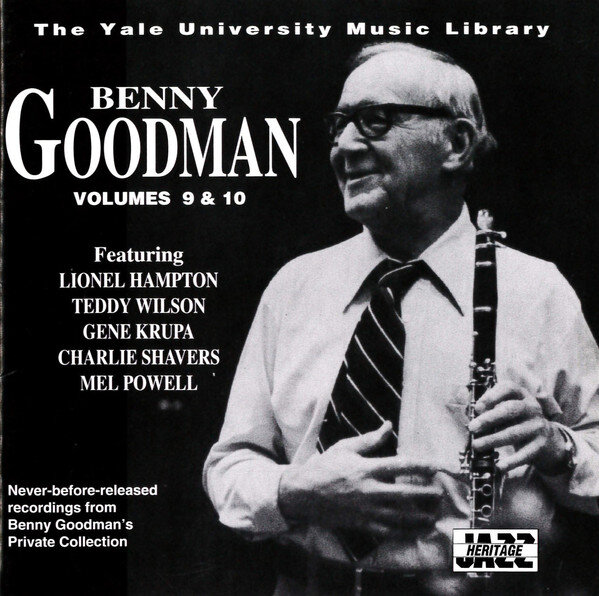 Based on our video collaborations, we thought that a roundtable discussion concerning the 1954 Benny Goodman Sextet would interest readers of The Syncopated Times. Because of space limitations, we are not able to discuss every track. However, we selected three representative performances to analyze.
Based on our video collaborations, we thought that a roundtable discussion concerning the 1954 Benny Goodman Sextet would interest readers of The Syncopated Times. Because of space limitations, we are not able to discuss every track. However, we selected three representative performances to analyze.
Several tracks on the Music Masters CD were played by a stellar trio: Goodman, clarinet; Mel Powell, piano; and Morey Feld, drums. But before we talk about the trio, let’s discuss one of the full band sides, with Charlie Shavers, trumpet; Steve Jordan, guitar; and the aforementioned Israel Crosby, bass. Loren, can you share some thoughts on the Sextet’s version of “Avalon?”
Loren Schoenberg: Well, it’s funny, I have mixed feeling about it, Hal. Let’s get one thing out of the way: it’s Goodman with a band of top players, well recorded, and on top of that, a band that we have no other recordings of, so by those parameters alone, it’s fair to dub it a classic. The problem comes, as D. Russ Connor noted in his classic BG On The Record, when the issue of self-comparison is raised—how does it fare when heard against the original Quartet versions? Goodman spent so many years playing the same material over and over again, that one can only be amazed at the spontaneity that he was able to summon for the untold-thousandth version of variations on the same basic chord progressions.
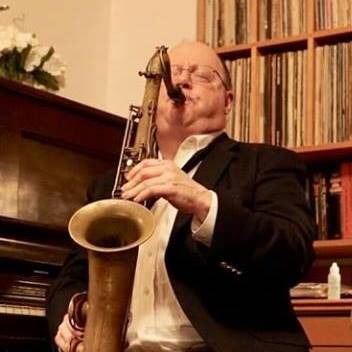
Mel Powell has spoken about how he didn’t feel that he really had a place in the post-war jazz world; that the music had gone in a different direction than the glory days of the ’30s through the early ’40s. His playing here, on the one hand so spectacular and inventive, jumps all over the place idiomatically, and that along with the booming (possibly too close to the mic) bass drum of Morey Feld during the trio segment impedes the naturalness that imbued the original versions, when Teddy and Lionel and Gene and Davey were still dealing with a new, fresh concept when confronting arrangements like this.
What makes this version unique is the entrance of the rest of the Sextet (Shavers/Jordan/Crosby) for a new riff chorus that is probably Powell’s, though who knows, maybe Shavers also sketched a few things out. There’s a man due for revaluation – a master trumpeter, composer, and arranger who had the misfortune of passing away just two days after Louis Armstrong, so there was next to no major press coverage—he just disappeared. Drummer Vernel Fournier told me that the first thing bassist Israel Crosby ever said to him was “You play too loud!” and that helps explain why Crosby is so hard to hear on almost all the recordings he made before his years with Ahmad Jamal. You feel him hear as much a hear his notes, but the blend with Jordan seems to be perfect (hear their hemiola figure in the last eight), and to cap it all off, when Feld goes to a his hi-hat and then a beautiful, light ride cymbal for the out choruses—well it just doesn’t get any better than that!
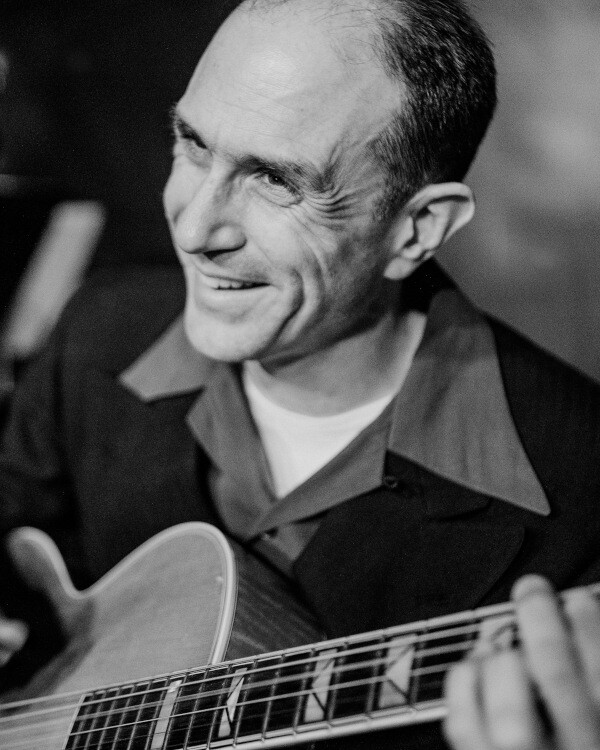
Nick Rossi: To roll it back a bit, I think it’s important to talk about what made this particular rhythm section such a standout combination. In my estimation, Steve Jordan was the last of the great Swing Era rhythm guitar players. He got in on the action just when the music had plateaued and before factors such as World War II hastened its decline. Jordan also pursued the craft well into the high-fidelity era of recorded music, so listeners really are able to get a good sense of his technique, approach, and sound. Hal, you’ve already revealed that we are all card-carrying members of the Israel Crosby fan club, so I won’t spend too much time on fanfare for him. But I do strongly feel that he was one of best musicians to ever play this music, even if he is less celebrated these days. The two played very well together, exceptionally so, both here and alongside Teddy Wilson on the Gene Krupa Sextet session recorded for Norman Granz in April, 1953.
While I do agree that that recording balance gives leaves something to be desired, I do think it is instructive in that it helps us latter-day rhythm players hear how to successfully build a rhythm feel. Feld was a solid swinger who had a fair amount of experience with Goodman and I suspect he knew what Benny liked. I know Loren has the inside track regarding Mel Powell during this period, but as I listen as objectively as I can, I can honestly say that I do enjoy his playing here. But I should be clear: I am a Mel Powell fan and would probably take lesser Powell over superior examples of many other players. Brief as it is on this particular number, the rhythm section very quickly establishes their rapport. It’s less of an exercise in dynamics as it is in locking-in quickly and keeping the momentum going that had been building over the first half of the song.
Regarding Shavers, yes, by all means, let’s kick-off that overdue revaluation right here! Charlie makes such a great entrance, impeccably matching Benny’s phrasing. I can’t help but think about John Kirby’s Sextet and all of the hours on the bandstand Shavers spent playing in the frontline with Buster Bailey – another player with Goodman connections. But here he is such a massive asset to the group and a big part of why I hold this assembly of musicians in such high regard.
HS: Loren mentioned that Goodman “spent so many years playing the same material over and over again.” This next song falls into that category as well: “Don’t Be That Way.” It’s interesting to contrast this sextet version with the many recordings by the full orchestra. Note that Shavers and Powell play the “pecks” that the wind instruments would normally play with the orchestra. The guitar and drums have a tight, chip-chip sound as opposed to what we hear in most recordings by the larger ensemble, though Morey Feld plays some bass drum “bombs” and accents on the snare.
Mel Powell goes pretty far afield from Edgar Sampson’s chords on the piano solo, and again behind the clarinet solo and Charlie Shavers’ swinging trumpet chorus. But the chord voicings don’t faze either of the hornmen. Everybody brings the volume down on the last chorus, and the ending sounds pretty abrupt – even considering the way it was usually played by the orchestra.
As a rhythm section player, there are some things I want to mention: First, listen to what a beautiful, big sound Israel Crosby gets on the bass, and how well-articulated his notes are. Second, my hat is off to Morey Feld for playing such cleanly-executed triplets with both hands! That is very difficult to do, but he makes it sound easy! Last, I notice that the tempo slows down considerably…but it is still swinging at the end.
LS: What interest me the most about this particular performance is that I could really hear Israel Crosby’s bass lines more clearly than the great majority of tracks on the album. He is so consistent, walking from the bottom to the top of the instrument with élan.
It would’ve been wonderful if he had had another opportunity to play with Mel Powell, who would’ve been sensitive enough to pick up on the subtle aspects of Crosby’s penchant for harmonic substitutions.
Powell is such a wonderful accompanist and it’s instructive to hear how he backs up the leader and then switches gears when Shavers comes in, aided by Feld’s welcome change of texture from the tight, marching sound he achieves from the start, with all of the quarter note snare sounds and receptive eighth-note chatter. All of sudden there are questioning chords that eventually subside into a more traditional sound. As for the piano solo, it is radically different from the light as a feather Powell of 1941-2, and the more Wilsonian stylings of 1945-6.
It’s hard to hear Steve Jordan, and I’ll leave it to our esteemed Nick to tackle the guitar issues. Amazingly—no drum solo!
NR: From a guitarist’s standpoint, this is one of more frustrating titles from the recording. It only takes about half of the running time before Feld starts to overpower Jordan. On one hand, it’s really too bad as there are several recorded versions of this song featuring Allan Reuss on guitar which may have provided interesting comparisons to Steve’s approach to the tune. I will say, however, that Jordan and Crosby find such a nice groove for much of Powell’s solo that one can almost overlook the remainder of the song.
At the same time, this is all a good reminder of how the rhythm guitar is just as important to the band as it is to the listening or audience, whether they are dancing, dining, or drinking. While this was particularly true ten to twenty years earlier than this sextet performance, I suspect the same principle applied to this particular edition of Benny’s small combo. All said, rhythm guitar at its best is a selfless job bereft of ego, truly in service of the music. Steve Jordan knew this as did the best practitioners of the art.
My point? Even if the listener is straining to dig the guitar out of the recording, we can all but assume that the band continued to benefit from Jordan’s groove. There is certainly evidence of this, particularly in Crosby’s playing which just dominates the rhythm feel. In spite of Feld’s accents, my perception is that Crosby is very much responsible for the overall character of the beat. Interesting too is how strong the third beat of each measure is during this performance and I feel that coming from the bass. However one feels this pulse, it’s a wonderful one and the bass player really makes this performance for me. This is easily some of my favorite bass playing on this particular tune, right up there with John Kirby’s finest moments on Chick Webb’s 1934 recording.
HS: For our last discussion regarding this live recording, let’s talk about “One O’Clock Jump.” Mel Powell plays a dash of Basie and also some more modern ideas. After the key change, we can hear the pulsating Jordan-Crosby-Feld rhythm section in the gaps when Charlie Shavers isn’t playing. To my ears, some of the phrasing on the trumpet choruses has a saxophone-like quality.
The bass drum is a little heavy—at least in the recording mix—but Feld kept a beautiful shimmer going on the ride cymbal for much of this performance. He also played more of those cleanly-executed triplets on the snare and toms and later a quasi-Latin beat with two eighth notes on the tom and two on the snare. In addition, he kept the song going after the last “triplet” chorus by the ensemble where it sounded like several band members were ready to wrap up the song!
LS: How many times had Benny already played this Count Basie blues by 1954? It has to be easily in the several thousands, and yet he finds inspiration in a simple Db blues and is as great as ever. Amazing.
The opening choruses in the key of F glide by quickly with some good Powell, and then the Ab7 comes and we’re off into the blues in Db. Charlie Shavers enters with a quote from the old song “My Sweetie Went Away,” and in this Basie context, it is more than likely a reference to Lester Young’s quote of that tune, immortalized on his 1943 recording of “Sometimes I’m Happy.” Shavers was quite the Lester Young fan, and there is more than one instance of him quoting Young solos verbatim during his years with the Tommy Dorsey Orchestra.
Listening to the rhythm section, we are confronted with the same issue of Morey Feld’s bass drum blocking most of Crosby’s notes, but if we listen carefully we can hear most of them, especially when brushes are being played. Crosby’s notes are just a bit longer than most of the players of his generation, and he seemed to approach harmony in a way that was different from most of his peers. As is the case throughout this entire session, he and Steve Jordan are in lockstep. They had played together in the 1953 Goodman band tour, so they clearly had a strong hookup.
Shavers was such a stone virtuoso that sometimes that takes precedence in trying to evaluate his playing, but he was a melodic improviser with a penchant for humorous quotes who also took bits of Roy Eldridge’s extroversion and penchant for climaxes at the end of every solo (no doubt with Armstrong as the root source) and made it his own. Note the manipulation of the trumpet valves while playing the same note here that is reminiscent of both cornetist Rex Stewart’s famous half-valve effects and also of Lester Young who famously did it on his original “One O’Clock Jump” solo. For all of Shavers’ influences, he is immediately identifiable after just a handful of notes.
Behind him, Powell branches out of a more traditional accompaniment, playing some very distant chords for a couple of choruses before retreating back to what Benny liked to hear. Powell was branching more and more out into his own compositional world, and one wonders if his mind was wandering, or whether he was adding an ironic element to the performances—we’ll never know, but it’s there for all to hear, and it swings.
D. Russ Connor, the father of Goodman bio/discography made a notable comment about the problem of assessing the relative value of Goodman’s work: the standard was so high that all subjective judgments had to be couched with the caveat of self-comparison. In that regard, this is at best an average Goodman solo. It’s not until Shavers’ riffs, amplified by Powell, that Goodman starts to rise to a level of moderate inspiration, but even then it’s a tad forced. The famous Basie riffs follow, and the band is somewhat stymied by their inability to properly mount the call and responses that are endemic to this piece. Powell’s humorous bass clef answers to the opening riffs signals that they’ll need all hands on deck to try and pull this thing off. To my ears, there’s a plodding quality to the rhythm section that makes this all the more difficult.
Performances such as these remind me that the least of Goodman’s work is still superior to all but the highest levels of jazz, and I’m thankful that this exists. It’s been decades since I produced these performances for issue, and listening closely, I wonder if we made an edit (something rarely done in the Yale Series), cutting out the walking bass chorus for some technical reason. If I ever can find the original copies of the tapes, I’ll be sure to share.
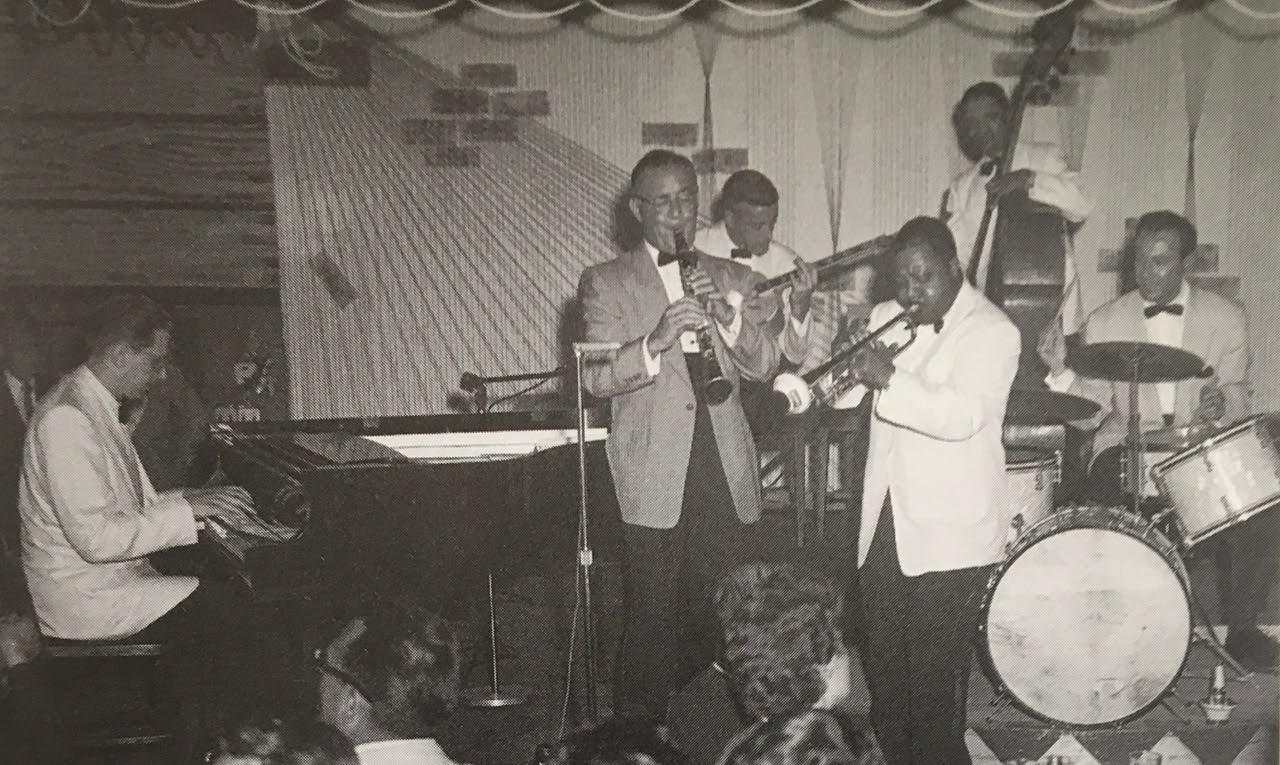
NR: This will shock no one, but I cannot hear a rhythm section play “One O’Clock Jump” without mentally referencing Count Basie’s original All American Rhythm Section. Jordan knew his blue Decca Basie records and knew them well. He had also, by this time, played with both Walter Page and Jo Jones. Steve knew Freddie Green personally and had a connection in terms of technique through their mutual teacher, Allan Reuss, with whom they each took lessons roughly around the same time. So, I think it’s a fair statement to say that Jordan was quite a student of that particular working unit. Page, as many have pointed out, was really the architect of the Basie rhythm section approach so one can only imagine how invaluable the experience of playing and recording with him must have been.
According to Jordan’s autobiography [Rhythm Man: Fifty Years in Jazz by Steve Jordan with Tom Scanlan, The University of Michigan Press, 1991—HS], Jones had some very strong opinions on how the rhythm guitar should be played. Steve dates an exchange to a Goodman sextet date for Capitol Records four months after this live recording, but Jones’ point of view was that the quarter notes should “roll out” as opposed to that snare drum-like snap a la Reuss that Benny preferred. The odd thing to my ears is that Steve is already letting his chords roll out a bit more on this title, well before that particular encounter with Jones. He’s got that relaxed drive of which Freddie Green was the acknowledged master and something a lot of subsequent rhythm players have worked hard to replicate.
Compare this, for example, to the titles he recorded in the spring of that same year with Buck Clayton for Columbia alongside both Page as well as Jones and Steve could almost be mistaken for a different guitarist entirely here. As a side trip, it’s also interesting to give another listen to Benny’s 1938 Victor record of this same title, Basie’s “only hit” as Jones called the tune: on that recording Allan digs in early on but starts laying back a bit letting his quarter notes roll out ever so slightly, possibly reflecting an early awareness of Freddie—who was still putting his approach together.
The whole Reuss-Green-Goodman dynamic is a great topic for another discussion, but I will say that this particular record was cut during a very interesting time for the Goodman band in terms of interpersonal politics. But returning to the Basin Street East recording, hearing a change in Jordan’s attack and approach does make me pause. While he certainly was no chameleon in terms of his playing, his performance does speak to the range of dynamics a really good rhythm player has—or at least should have—at their disposal. Yes, we are talking fairly subtle nuance here, but a very important one for any working musician sitting in the rhythm guitar chair for several sets of music or a long recording session. But my burning question is: who is singing those faint background riffs behind Shavers first two choruses?
HS: Unfortunately, we won’t be able to answer Nick’s question before this roundtable of three signs off for the moment. Thank you, Loren and thank you, Nick for your expertise and your thoughtful responses. I hope that we might participate in another discussion like this in the near future. I also hope this article will inspire The Syncopated Times readers to seek out the recordings from Basin Street East in 1954, played by an outstanding combination of musicians which never recorded again as a group!
Loren Schoenberg, Nick Rossi and Hal Smith can be heard on the video series GET HAPPY: The Benny Goodman Big Band Sessions, 1934-36 on YouTube.
Hal Smith is an Arkansas-based drummer and writer. He leads the El Dorado Jazz Band and the
Mortonia Seven and works with a variety of jazz and swing bands. Visit him online at
halsmithmusic.com























